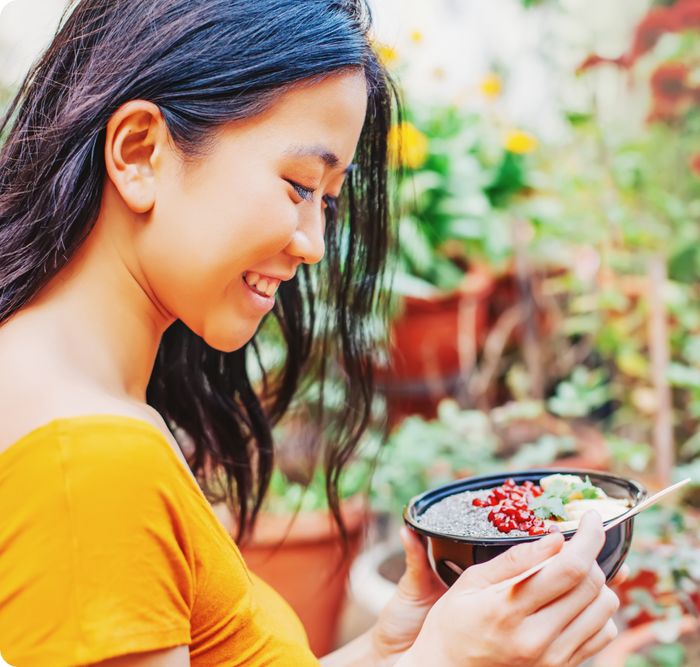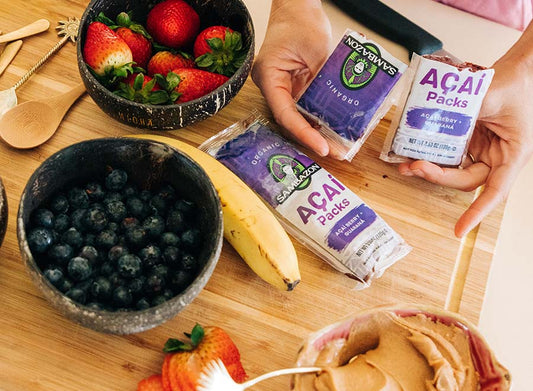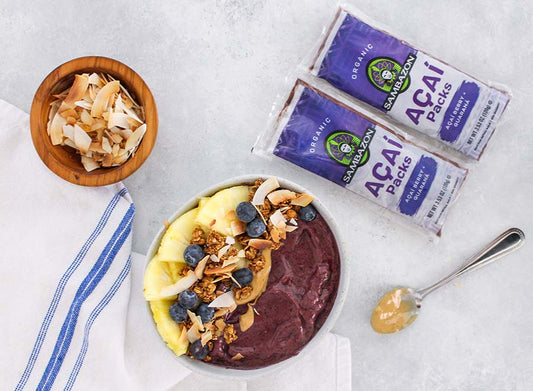If you’ve been to a supermarket, health food store, or smoothie shop during the past few years, you’ve probably heard of Açaí. Beyond its ability to elevate meals and snacks, how much do you really know about the mysterious fresh fruit ingredient?
What is Açaí made of? In this article, we’re going to break down some must-know facts about this one-of-a-kind fruit. We’ll discuss its history and surge to popularity, its categorization as a “superfood,” and detail how a tiny Amazonian fresh fruit becomes a silky, scrumptious Açaí puree. Plus, we’ll answer a second burning question—“What is an Açaí bowl made of?”—and explore numerous other tasty recipes.
By the time you’re done reading our quick guide to Açaí, you’ll be an expert—and maybe even a little hungry for an Açaí smoothie bowl. Prepare yourself for a mighty Açaí craving.
All About the Amazon’s Favorite “Berry”
Before we talk about recipes, let’s cover the anatomy, history, nutritional value, and processing of the Açaí berry—which, surprisingly, isn’t a berry at all.
Açaí Anatomy
What is Açaí made of?
While it’s usually referred to as a berry, Açaí is—in fact—a drupe. A drupe is a seed with three layers:
- The outer layer
- The fleshy layer
- The hard shell layer encasing a seed
Other drupes include olives (the word is derived from the Greek word drupa, which means “overripe olive”), coconuts, and peaches. While each of these features three layers, none of them quite match the qualities of the Açaí fruit.
History of Açaí
So where does Açaí come from? Açaí grows on palm trees throughout the Amazon rainforest and was primarily consumed by Brazilians until the early 2000s when the unique Açaí berry fruit took the US by storm.
Açaí’s original consumers harvested the fresh fruit by shimmying up the slender palms, cutting down a stalk full of the pea-sized fruits, and climbing back down with their bounty. They primarily turned the fresh berries into a paste or thin puree to be enjoyed alongside meat and fish dishes—many Brazilians still consider meals incomplete without a side of Açaí berry puree.
In the 1970s, the folks from the Amazon region began migrating into cities and down to the South of Brazil, bringing Açaí with them. It entered the urban nutritional scene via roadside vendors, who sold the Açaí berry puree in Ziploc bags to passers-by. When Açaí hit the city of Rio de Janeiro, vendors there began selling homemade Açaí bowls, which were sweet and typically served with a sliced banana, fresh berries, and granola.
Within just a few decades, a fruit primarily eaten by indigenous people for centuries became an international staple as the demand for this purple, pulpy puree migrated to North America.
Superfruit Status
What is a superfruit? While it’s not an actual dietetic term, it rose in prominence after Dr. Nicholas Perricone, a New York-based anti-aging specialist, coined the term “superfood” in his 2003 book The Perricone Promise: Look Younger, Live Longer in Three Easy Steps. In Perricone’s opinion, superfoods are highly concentrated with a few essential nutritional components:
- Antioxidants
- Vitamins
- Fiber
- Nutrients
From Berry to Blend
So, how do tiny, firm berries growing on palms in the Amazon end up in a pre-packaged, frozen Açaí puree available at the grocery store? Let’s explore the process:
- Harvesting – We work directly with Amazonian farmers and harvesters to collect Fair Trade and Certified Organic Açaí in a manner that’s minimally disruptive to local ecosystems.
- Selecting – After transporting the berries from growing sites to our processing facility, we inspect them on the dock for ripeness, quality, aroma, and color to ensure a high-quality frozen Açaí puree.
- Eco-processing – SAMBAZON features some of the most technologically advanced, ethical, and eco-friendly food processing facilities in the world. Our team soaks the raw Açaí in water, extracts the pulp, pasteurizes the mixture to prevent foodborne illness, and packages and freezes the puree right on site.
Our goal is to bring Açaí from the palm of a tree to the palm of your hand, and that couldn’t happen without our dedicated team of harvesters.
But Açaí production isn’t just about processing—it’s about introducing the world to a delicious, nutritious frozen fruit while honoring its historical significance and original consumers. At SAMBAZON, three elements dominate our decision-making and operations:
- People – We invest a portion of our profits back into our communities of harvesters to help fund education, healthcare, and recreation among local communities in Brazil.
- Planet – Our commitment to organic growing is so much more than a certification—it’s a massive effort to help support the biodiversity of the Amazon, protect native species, and operate with as small a carbon footprint as possible.
- Prosperity – Açaí harvesting and processing is making a significant economic impact in the lives of Brazilians, creating a ripple effect that bolsters the local, regional, and national economy.
The World’s Favorite Açaí Recipes
Now that you’re up-to-date on Açaí’s anatomy, history, nutrition facts, and processing, let’s get to the juicy part—delicious Açaí smoothie bowl recipes you can create with Açaí purees:
- Homemade Açaí Bowls – Drop in a frozen Açai superfruit packet into a smoothie blender and blend until the mixture is thick. Top it with almond butter, or whatever you’d like—or enjoy it without any toppings at all. Some fan-favorite toppings include sliced fruit, granola, coconut flakes, chocolate, and nuts.
- Smoothies – Açaí’s silky texture make it an excellent addition to any smoothie. Whether you make a delicious blend at home with your own ingredients like pitaya or other fruits or pick one up at a smoothie bar, you’re sure to enjoy this frozen Açaí treat. Make sure you learn how to store smoothies as well so you can enjoy Açaí all week long!
- Juice – Sometimes, you just need a refreshing drink to re-energize you, ground you, or simply wet your palate between bites of a tasty meal. Açaí aficionados love the vibrant taste of Açaí juice, which can be added to smoothies, cocktails, mocktails, and more.
- Desserts – Açaí can also make for the perfect desert! SAMBAZON’S Superfruit Açaí Bites contain refreshing organic Açaí Berry sorbet dipped in vegan, rich dark chocolate, making it a delicious guilt-free treat with 50 calories & 4g of sugar.
SAMBAZON: Making Your Favorite Açaí Products Since 2000
There’s many things that make Açaí special. Without the marvels of international commerce, the US would have never been introduced to this centuries-old, native Amazonian drupe. After we harvest, inspect, and process the fruit into frozen purees, it makes the perfect addition to countless tasty dishes.
At SAMBAZON, we’re all about honoring that historical legacy and the people who help make Açaí possible. We don’t just provide delicious, nutritious Açaí products to health-conscious people—we genuinely care about the people who make, love, and deliver our purees, juices, drinks, and bowls.
Whether you’re craving a bowl with crunchy granola, a thick smoothie, or an out-of-this-world dessert, SAMBAZON is here to help you discover the power—and downright deliciousness—of Açaí.
Sources:
Library of Congress. Is a Coconut a Fruit, Nut or Seed? https://www.loc.gov/everyday-mysteries/item/is-a-coconut-a-fruit-nut-or-seed/
The New Yorker. Strange Fruit. https://www.newyorker.com/magazine/2011/05/30/strange-fruit-john-colapinto
SAMBAZON. Nutrition Facts. https://www.SAMBAZON.com/products/pure-unsweetened-frozen-açaí-packets
National Institutes of Health. açaí. https://www.nccih.nih.gov/health/açaí
US Department of Agriculture. Fruits. https://www.myplate.gov/eat-healthy/fruits







Comments
(0 Comments)Please note, comments need to be approved before they are published.